Scottish Economic Statistics 2008
This is the ninth edition of the annual publication Scottish Economic Statistics, which is produced by statisticians in the Scottish Government.
B1 chapter one: Economic Accounts
GDP growth
In the calendar year 2007, Scottish GDP (Gross Domestic Product at Basic Prices) grew by 1.8 per cent against the previous year. The service sector was largely responsible for the overall growth, demonstrating an annual growth of 2.9 per cent. The production sector declined by 0.9 per cent over the same period and construction also fell by 2.1 per cent. Within production, the manufacturing sector grew by 1.0 per cent. Mining & quarrying declined by 6.8 per cent and electricity, gas & water supply fell by 8.7 per cent.
Industry sectors with largest annual growth in 2007*
- Real Estate & Business Services (+3.9 %)
- Transport, Storage & Communication (+9.8%)
- Retail and Wholesale (+3.4%)
- Other services (+4.6%)
- Financial Services (+1.9%)
Industry sectors with largest negative annual growth in 2007*
- Electricity, Gas and Water Supply (-8.7%)
- Construction (-2.1%)
- Mining & Quarrying (-6.8%)
- Paper Printing & Publishing (-5.0%)
- Hotels & Catering (-1.7%)
* in terms of influence on overall GDP growth; i.e. growth x weight.
Between 2000 and 2007, Scottish GDP grew by 14.3 per cent, equating to an average annual growth rate of 1.9 per cent. Chart 1.2 shows the change in annual growth rate since 1998 for Production, Services and overall GDP. The growth rate for GDP as a whole has grown within a range of around 1.5 to 2.5 per cent. Since the end of 2000, the production sector has experienced negative annual growth for the most part, largely due to the contraction of the electronics sector. The rate of decline in production exceeded 7 per cent. Chart 1.2 in the first three quarters of 2002 but in more recent quarters has settled into a range between -2 per cent. Chart 1.2 and +0.5 per cent. Chart 1.2 . Conversely, the service sector has acted to offset the decline in the production sector by showing strong annual growth consistently over the period reaching a peak of 5.2 per cent. Chart 1.2 during the start of 2002.
The service sector is the largest sector in the Scottish economy, accounting for 73.8 per cent of GDP, while production accounts for 17.8 per cent. Construction and agriculture, forestry & fishing contribute the least to the overall GDP (6.8 and 1.8 per cent respectively). The relative importance of industries to the economy as a whole has changed over time, with the service sector growing in importance and production, construction and agriculture, forestry & fishing reducing - see chart 1.3.
Chart 1.1: Scottish GDP index 1995 Q1 - 2008 Q2
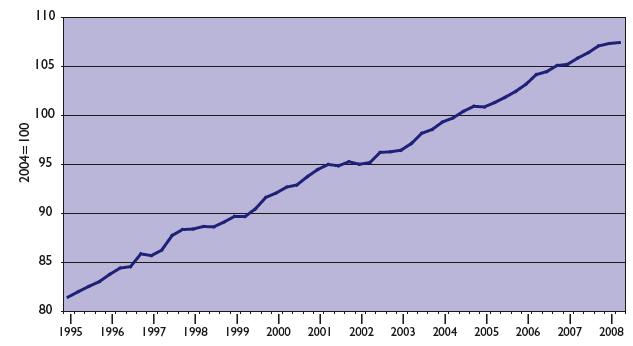
Source: Scottish Government
Chart 1.2: Year on year GDP growth, 1998 Q1 to 2008 Q2
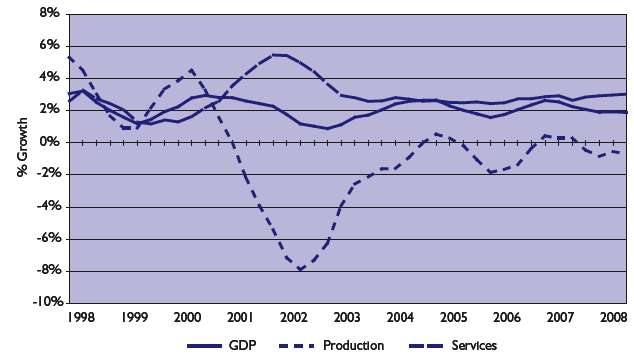
Source: Scottish Government
Chart 1.3: GDP weights of main industries, 1995 and 2004
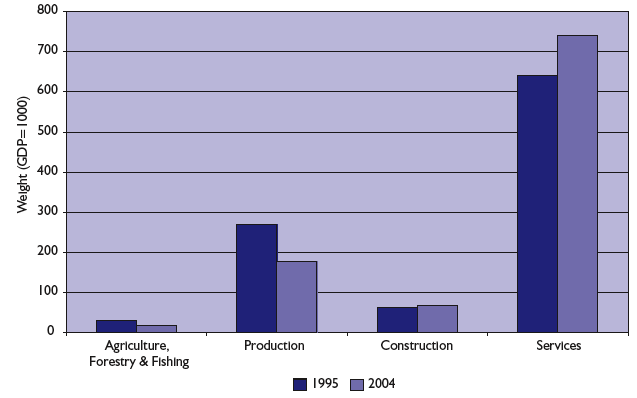
Source: Scottish Government
Value of GDP
The above section describes the quarterly index of Scottish GDP at basic prices (known as Gross Value Added ( GVA) under ESA 95). This is produced by the Scottish Government 17 weeks after the end of the relevant quarter, and provides an indicator of economic growth. It does not, however, provide a monetary value for GDP. An estimate of this in current prices is provided by the Office for National Statistics Regional Accounts. The Regional Accounts take UK totals from the National Accounts, and apportion these to the regions of the UK. Scottish GVA was estimated as £91 billion in 2006. Estimates for 1995 to 2006 are shown in Table 1.2. Table 1.3 gives a breakdown by geographical ( NUTS 3) area comparing 1995 to 2005. The next release of Regional Accounts GVA data by ONS will be on 12th December 2008, and can be found on the ONS website at http://www.statistics.gov.uk/StatBase/Product.asp?vlnk=7359.
Supply and Demand
The Scottish input-output tables provide a detailed snapshot of the supply and demand linkages that exist within the economy. For the latest set of input-output tables, for 2004, a number of methodological changes have been made. Some new taxes, such as Climate Change Levy, Aggregates Levy, and Renewable Obligations Certificates, have been incorporated into product tax estimation and, as far as possible, these figures have been constrained to Government Expenditure and Revenue Scotland figures.
Table 1.4 shows that total supply at purchaser's prices for 2004 was £236 billion. Of this, 36 per cent (£84 billion) was consumed by Scottish industries during their production process, 27 per cent (£63 billion) by consumers, 20 per cent (£47 billion) was exported from Scotland and 11 per cent (£26 billion) was consumed by government. Chart 1.4 shows that the picture is different for individual industries, with around 30 per cent of manufacturing products being exported, while almost 65 per cent of Education, Health and Social Work products are consumed by government.
Chart 1.4: Demand for commodities, 2004
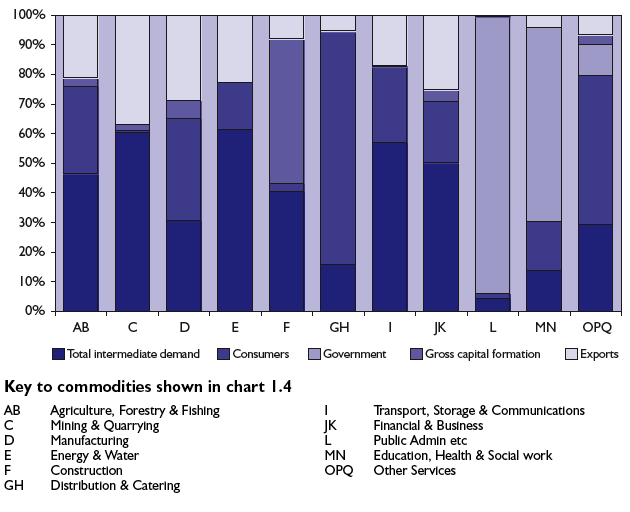
The primary purpose of the Supply table ( Table 1.5) is to show the monetary value of goods and services (commodities) produced by each industry in Scotland in 2004, along with the supply of commodities through imports. The supply of commodities is presented in the rows while the columns show the industries responsible for the output of these commodities. The distinction between industries and commodities is important; individual firms and organisations are classified according to the products they make. If an industry produces more than one product, it is classified according to whichever product accounts for the largest proportion of its output. Each industry produces what is termed to be its principal product (shown in the diagonal elements in the Table 1.5) and many industries also produce a range of other commodities referred to as secondary production (shown in the off-diagonal cells). Some industries such as Public Admin almost exclusively produce their principal product, whereas industries such as Distribution and Catering are more diversified.
The Combined Use matrix ( Table 1.6) shows the purchases of commodities made by each industry required in order to produce its output, as well as the purchases of each product by final markets. In 2004, the input-output GVA and Compensation of Employees were both constrained to the Office for National Statistics Regional Accounts at the 32 industry group level.
For the analysis of industry linkages and economic impacts, it is more meaningful to represent the Use matrix in Industry by Industry (IxI) ( Table 1.7) form, although a Commodity by Commodity matrix is also produced. The columns of the IxI matrix show purchases made by industries from each industry, and final demand for each Scottish industry's output arising from both principal and secondary production.
Industry Multipliers
The input-output model provides the tools to follow the final demand changes through the whole economy and estimate the total effect on the Scottish economy. It enables analysis of the effect of different types of changes in final demand, for example, the closure or opening of a company, an increase in consumer spending due to a change in (for example) disposable income, or an increase in exports. In addition, the input-output model includes sets of industry level multipliers, to reflect that the total impact on output will vary according to the industry which experiences the initial change in demand.
There are different types of effects, direct, indirect and induced. If there is an increase in final demand for a particular commodity, it can be assumed that there will be an increase in the output of that commodity, as producers react to meet the increased demand; this is the direct effect. As these producers increase their output, there will also be an increase in demand on their suppliers and so on down the supply chain; this is the indirect effect. As a result of the direct and indirect impacts, the level of household income throughout the economy will increase as a result of increased employment. A proportion of this increased income will be re-spent on final goods and services: this is the induced effect. The industry multipliers measure these impacts on each industry - Type I multipliers measure the direct and indirect effects, Type II multipliers also measure the induced effect.
Separate multipliers measure the effect of change in industry output, employment (number of FTE jobs) and income from employment. The output multiplier, and employment and income effects show the impact which a change in an industry's final demand would have on the total output, number of jobs, and income from employment throughout the Scottish economy. The income multiplier shows the increase in income from employment resulting from a unit increase in income from employment ( i.e. compensation of employees). The employment multiplier shows the increase in employment resulting from an increase in final demand sufficient to create one additional job ( FTE) in that industry.
There are a number of assumptions which are made in the production of industry multipliers. When looking at the effects of changes on the Scottish economy, the model assumes that output would be reduced in line with the reduction in demand. However, it is possible that, following the decrease in final demand for a product, an industry would use its spare resource to increase output of another product. In addition, the industry multipliers provide an estimate of the impact of change by assuming that the industries and consumers will follow current purchasing patterns.
The following hypothetical examples illustrate the effect which a change in the number of jobs and the final demand would have on two industries.
Example 1
A company opens in the "Computing Services" industry ( IOC 107), employing 100 people on a full-time basis. The creation of the 100 full time jobs is the direct impact, the number of jobs created by indirect and induced effects are calculated below.
- The increase in jobs due to direct and indirect effects is calculated by multiplying the direct increase in jobs (100 FTE) by the "Computing Services" Type I employment multiplier (1.280), giving 128 new full-time equivalent jobs. Subtracting the initial direct job increase gives the increase in jobs throughout the Scottish economy due to indirect effects as 28 ( FTE).
- The increase in jobs due to direct, indirect and induced effects is calculated by multiplying the direct increase in jobs (100 FTE) by the "Computing Services" Type II employment multiplier (1.617) giving 162 FTE jobs. As 128 FTE jobs are as a result of direct and indirect effects, it is estimated that 34 further jobs will be created as a result of this induced demand.
Example 2
The following example looks at the effect of an additional £5 million of exports to the Rest of the World by the "Manufacturing of Other Inorganic Basic Chemicals" industry ( IOC 37). The direct impact on the industry is an increase in total output by £5 million to meet this additional final demand. The other effects are calculated as follows:
- The change in output due to direct and indirect impacts is calculated by multiplying the direct output change (£5m) by the Type I output multiplier for this industry (1.620), giving an increased output of £8.1 million (of which £3.1 million would be due to indirect effects).
- The change in employment resulting from this additional output is calculated by multiplying the direct output change (£5m) by the Type I employment effect (8.068) for this industry, giving 40 FTE jobs created directly and indirectly throughout the Scottish economy.
- If employment were to rise, it is expected that there would be an associated rise in household income as these new posts are filled. The income effects estimate the effect of the direct change in output upon household income in Scotland - this is calculated by multiplying the direct output change (£5m) by the Type I income effect for this industry (0.300) to give an estimate of £1.5m of the direct + indirect income changes resulting from this additional output.
Direct, indirect and induced effects can be estimated using the Type II multiplier, rather than the Type I multiplier in the above calculations.
The Scottish Input-Output Supply and Use tables and associated analyses rely heavily on the UK Supply and Use tables and are constrained to the Regional Accounts based estimates of Gross Value Added ( GVA) at the 31 industry level (and financial intermediation services indirectly measured). Due to the re-engineering programme currently being carried out by the Office for National Statistics ( ONS) a number of their products have been temporarily suspended, including the production of the 2005 UK Supply and Use tables and Regional Accounts industry level GVA.
As a result of these changes, publication of the 2005 Scottish Input-Output tables, scheduled for December 2008, will also be delayed. However, a full set of revised tables for 1998-2004 will be published in early 2009, which will allow users to perform analyses on a consistent time series of input-output tables. Further information about the Scottish input-output tables is available at http://www.scotland.gov.uk/Input-Output or from Donna Hosie ( donna.hosie@scotland.gsi.gov.uk).
Scottish Exports
Introduction
The two main sources of published data on Scottish exports are the annual results from Scotland's Global Connections Survey ( GCS) and the quarterly index of Scottish manufactured exports. The GCS provides cash estimates of the value of export sales across all sectors of the Scottish economy, whereas the quarterly index serves as a time series of the changes in the level of manufactured export sales.
GCS estimates are available for the period 2002-2006, with the results of the 2007 survey planned for publication in January 2009. Tables 1.8 and 1.9 show the results from the 2006 survey by industry and destination.
The quarterly index of Scottish manufactured exports provides estimates of changes in the level of exports from manufacturing industries over time, adjusted for inflation. Table 1.10 gives data on this by industry.
A full range of export statistics from both sources can be found on the Scottish Government web-site at www.scotland.gov.uk/exports along with background on estimation methodology.
All exports
- In 2006, total Scottish exports were estimated to be £20.6 billion, of which nearly two-thirds (£13.6 billion) were attributable to manufacturing companies.
- The top five exporting industries in 2006 were food and beverages (£3.7 billion - of which alcoholic beverages accounted for over 88 per cent), chemicals (including refined petroleum products) (£1.9 billion), the wholesale, retail and accommodation sector (£1.8 billion), business services (£1.8 billion), and office machinery (£1.6 billion). Together these industries accounted for more than half of total exports.
- Manufactured exports were estimated at £13.6 billion (66 per cent of total exports). Within the manufacturing sector, the electronics industry as a whole (defined as SIC divisions 30-33) had estimated exports of £3.9 billion, accounting for 29 per cent of manufactured exports and 19 per cent of total exports.
- The top exporting service sectors were wholesale, retail and accommodation (£1.8 billion - 30 per cent of total service exports), business services (£1.8 billion - 29 per cent of total services exports), financial intermediation (£1.1 billion - 19 per cent of total service exports) and transport (£0.6 billion - 10 per cent of total service exports).
- The top destination country for Scottish exports was USA, which accounted for an estimated £1.8 billion of exports (9 per cent of total exports). The second largest exports destination was France which accounted for an estimated £1.6 billion of exports (8 per cent of total exports) closely followed by Germany which accounted for an estimated £1.5 billion of exports _(7 per cent of total exports).
- The top five export markets ( USA, France, Germany, Netherlands, and Eire) accounted for £7.3 billion of exports (35% of all exports) from Scotland.
Chart 1.5: Scottish exports by grouped industry sector, 2006
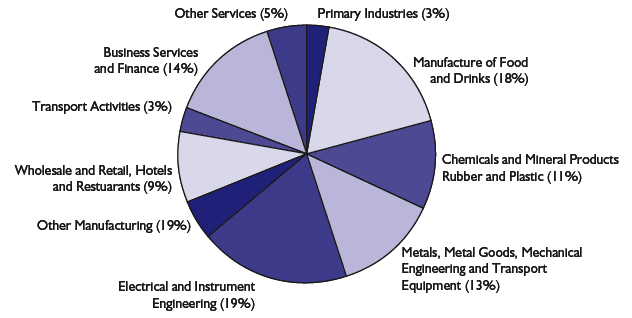
Source: Scottish Government
Manufactured Exports
The Index of Manufactured Exports is published quarterly and provides information on the change in the volume of overseas exports (in constant prices) for each quarter from 1995 Q1.
The latest figures, published on 1st October 2008, cover the period from 1995 Q1 to 2008 Q2 and are available here: http://www.scotland.gov.uk/Topics/Statistics/Browse/Economy/TrendManufacturedExports
Over 1995 Q1 to 2000 Q4, the index of manufactured exports exhibited a period of strong growth (1.9% average quarterly growth) which was followed by a sustained period of decline from 2000 Q4 to 2004 Q4 (2.7% average quarterly decline). Thereafter there has been some evidence of modest trend growth in export sales.
The growth and decline in manufactured exports over the period 1995-2004 is largely explained by the electrical and instrument engineering sector which grew by 95.7 per cent between 1995 and 2000 and fell by 66.0 per cent between 2000 Q4 and 2004 Q4.
At its peak, in 2000, the electrical and instrument engineering sector accounted for 58 per cent of Scotland's manufactured exports. This industry remains Scotland's largest exporting sector and accounted for 33 per cent of Scotland's total manufactured exports in 2007.
Chart 1.6 Index of Scottish Manufactured Exports, 1995 Q1 - 2008 Q2
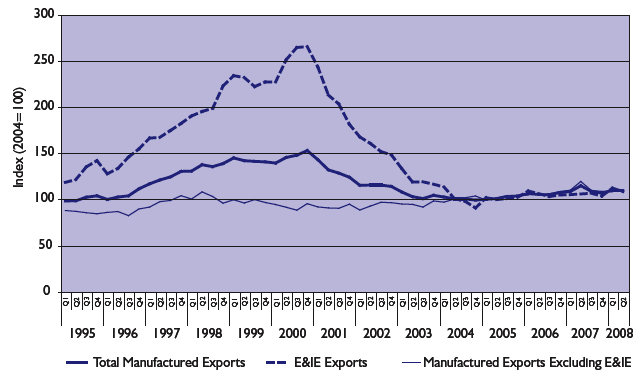
Source: Scottish Government
There is a problem
Thanks for your feedback